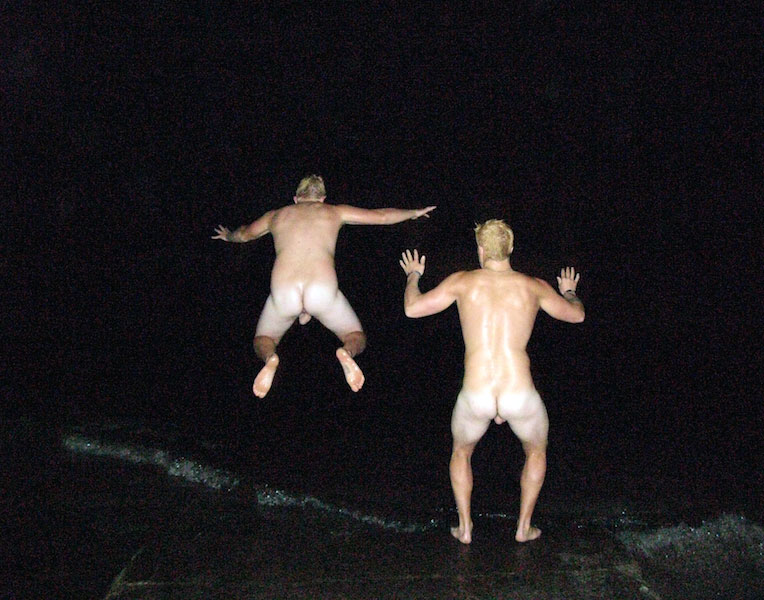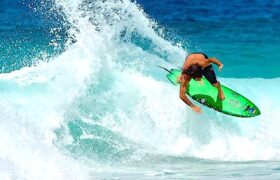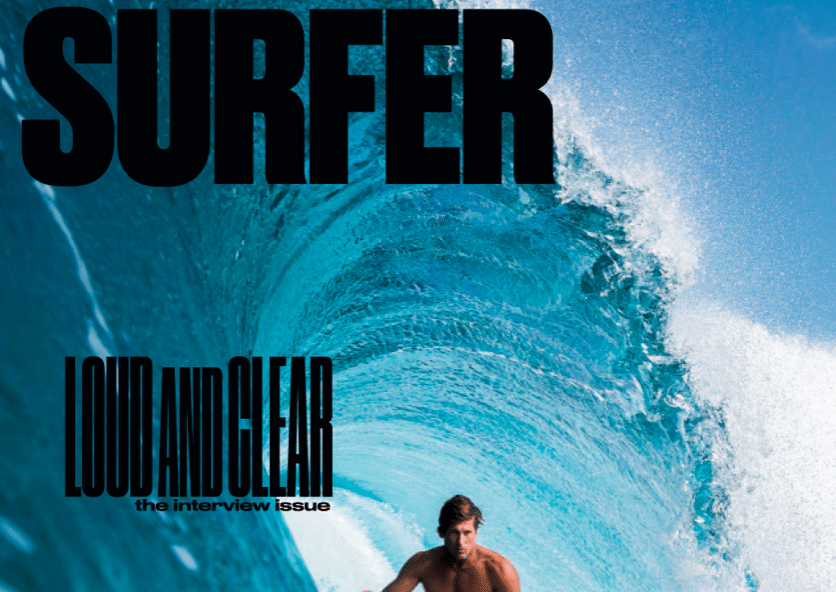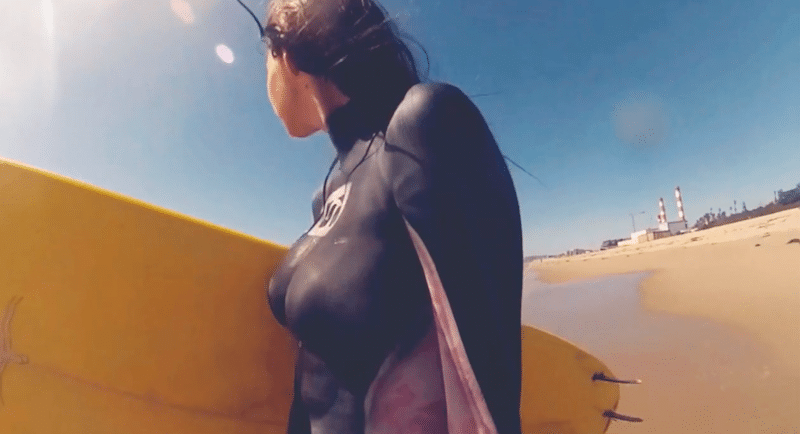Surf label studs from Malibu love to French kiss and flabbergast!
It’s the 2006 Malibu Classic and the waves are waist-high and lackluster, the couple hundred gathered around the contest site looking slightly bored in the honeyed afternoon light.
In a kind of send-in-the-clowns rescue effort, event organizers decide to put on a same-sex tandem heat, which inspires wry grins on the faces of Trace and Chad Marshall. Trace slips into his purple short john, Chad borrows a pair of acid wash cut-offs and a red bikini top from a girl called Soul Mama.
Trace grabs Chad by the hips and proceeds to dry hump him from behind. He pumps, pumps, pumps and his brother writhes, writhes, writhes. Chad turns around, drops to his knees and proceeds to simulate oral sex on his big brother. Trace reciprocates. The beach is flabbergasted.
They paddle out on a thick longboard and assume position at the very top of First Point. When the wave of the day comes, they spin around, stroke, and hop to their feet. And then in a move that’s more the kind of thing you find atop a gay pride parade float, Trace grabs Chad by the hips and proceeds to dry hump him from behind. He pumps, pumps, pumps and his brother writhes, writhes, writhes. Chad turns around, drops to his knees and proceeds to simulate oral sex on his big brother. Trace reciprocates. The beach is flabbergasted. The garrulous announcer has fallen silent and the teams from Santa Cruz, San Clemente, San Diego and Japan are all in shock. Not since Dora’s famous BA in ’67 has Malibu seen such flagrant perversion across its ruler-edged righthanders.

And then when they hit that bend in inner First Point where the wave seems to be crafted by machine and the image of surfer, pier and Santa Monica Mountains appears as a kind of postcard of the California Dream, Trace lifts Chad above his head and Chad arches his back with a kind of cheerleaderish grace, his arms in swan, his toes perfectly pointed. They hold the pose long enough to draw applause from the entire beach, long enough for the judges to scribble perfect 10s on their score sheets, long enough for their mastery to trump their irreverence.
And that, ladies and gentleman, is but a single ride in the whirlwind shuffle that is being Brothers Marshall.
The Marshall Bros, aka the Gay Brothers, have made a career out of pulling outrageous stunts. Wherever they sniff out taboo in the surfer psyche they attack, attack, attack. They’re court jesters, agent provocateurs, hole-pokers in the stereotype.
When a display of heated machismo broke out during a recent club contest at San Miguel, it was a Marshall who planted a French kiss on the perpetrator, diffusing the fight and bringing mirth to an entire parking lot.
When surfing went all black wetsuit/clear board in the mid-‘90s it was the Marshalls who sported hot pink and fluoro turquoise. When their fellow competitors turned jockish and traveled with extensive quivers, Trace and Chad showed up to events half-drunk and boardless. When a display of heated machismo broke out during a recent club contest at San Miguel, it was a Marshall who planted a French kiss on the perpetrator, diffusing the fight and bringing mirth to an entire parking lot.
When it seems that every beaver tail-wearing, acid splash fish-riding alt-surfer is also a shaper/painter/photographer/musician/filmmaker, Brothers Marshall make a mockumentary taking the piss out of all the above, the innate self-incrimination precisely the point. But then just when their shenanigans seem to upstage their watery prowess, just when the naysayer might accuse them of being all humor and no substance, they’ll paddle out and serve up some of the craftiest, most original longboarding the world’s ever seen.
1982. Jim Marshall is a high school senior surfer/skater from the valley who doesn’t mind a good scrap. At a dive bar in North Hollywood he finds himself shooting pool with Dionne, a hot blonde whose three-dot Mi Vida Loca tattoo suggests a taste for the wild. Beer is swilled, eight balls are banked into corner pockets. And then just when the night’s hitting its stride, Dionne’s C14 Westside boyfriend Psycho shows up with his homeys and proceeds to call Jim out. It’s a dual straight out of Westside Story. Fists fly, bottles break, and pool cues snap. In the end Jim emerges the victor and so begins the courtship of the future Mr. and Mrs. Marshall. A year later Trace is hatched, two years later Chad, and six years later DJ.
Jim takes a job with the LAPD. By the time the boys are seaworthy he’s working Hollywood Vice night shift. Amongst his busts are pimps, prostitutes, raging crackheads and A-list celebrities. He dodges bullets during the Rodney King riots. He still has the scar from when a savage drag queen tried to bite his ear off. To curtail the madness, he arrives home in the mornings, loads the kids and 9’4” Kennedy in the station wagon, and heads to Malibu. Between surfs he catnaps on the beach, during which time twelve-year-old Trace and ten-year-old Chad take turns riding whitewash at the bottom of First Point.
It’s not long before they’re totally hooked. Not only by the glory of standing on a board and streaking across water, but by the endless beach party that is the scene at First Point. They bop their heads to Billy Bear’s guitar strumming; they overhear Angie Reno’s detailed accounts of early Pipeline. They marvel at Josh Farberow’s, Jimmy Gamboa’s and Dane Peterson’s ace nose riding. On south swells, they’re treated to Joel Tudor’s and Herbie Fletcher’s mastery. And then one day they put it together that these are the very same guys they’ve been watching in videos like Power Glide, Blazing Longboards, and Siestas and Olas.
“We were just these kids from the valley, standing on the edge of the best surfers in the world, totally in awe,” says Trace. “If we were lucky we’d get a head nod. But what broke it was my little brother. One day we get out of the water and DJ, who’s six at the time, is giving tacos to some model chick. Then the next thing you know he’s tossing a football back and forth with Josh Farberow. And then the next thing you know me and Chad join in, and from that point on we started hanging out under the palapa and raging with this whole multi-generational crew.”
It was a tutelage that would resonate profoundly. Had Mr. Marshall chosen a perch 200 yards further up the point the brothers may have become God-fearing, thruster-riding NSSA kids, but as it were they had an entirely different coming of age. Trace remembers smoking joints with old salty dogs that’d listen to smooth jazz through transistor radios; Chad recalls endless parties in beachfront palaces where he’d wake up amongst a sea of bodies and beer bottles and overflowing ashtrays—“I’m pretty sure that was the summer I lost my virginity.” But as much as they were getting a crash course in barefoot hedonism, so too was their surfing progressing in leaps and bounds.
“Josh Farberow taught us how to read the wave at First Point,” says Trace. “He was the one who told us we needed to go way outside and surf all the way across the point. He also told us to surf for yourself. This was when longboarding was exploding and there were always cameras around and he was like, ‘Don’t pose. Just surf for the feeling. It’s about going from Point A to Point B…’”
The next arc in our story comes in ’96 when Jim and Dionne divorce and Jim moves to Manhattan Beach. Though unfortunate as far as the family goes, it was a blessing in disguise with regards to Trace and Chad’s surfing. All they’d ever known was the long, tapered walls of Malibu, and suddenly they were bouncing around the mercurial beachbreaks of the South Bay. Chad remembers: “We’d be staying with my dad in Manhattan Beach and a big swell would come in and we’d jump off the end of the pier. Everyone thought we were crazy ‘cause we were riding longboards. We were like, Let’s think outside the box and do weird stuff—fin first nose rides, fin first tube rides, these weird nose ride floaters… We’d go back to Malibu and do it on clean waves and it was a piece of cake.”
They surfed their first contest in ’97 and both won, Trace taking the Juniors, Chad the Menehune. And then just a few weeks later they found themselves pounding Bloody Marys on a plane bound for Sydney in what’s a story straight out of the Dora Handboook.
Amongst the melting pot of Malibu they’d befriended Henry Holmes, a renowned entertainment lawyer whose beachfront pad they’d hang out at between surfs. Holmes had a soft spot for the Brothers Marshall and when they mentioned the upcoming Noosa Festival of Surfing in Australia and the fact they had no money to get there, Holmes set up a travel fund. Amongst the contributors: Pamela Anderson, Hulk Hogan, George Foreman and an array of other dubious celebrities.
It was a headfirst plunge into the higher echelons of longboarding. They stayed at the Four Seasons, shared waves with Nat Young, Greg Noll, Bob McTavish, and Joel Tudor, and got hammered in the hotel bar with all their heroes. Chad placed second and Trace got puked on by one of the top female noseriders of the time. “It felt like we’d stepped into Blazing Longboards,” recalls Chad. “Only in this version we were co-stars.”
They spent the next couple years chasing contests from Santa Cruz to San Miguel. And though they made the finals of virtually every event they entered, their run would be short lived. “We loved the fun of hanging out with friends up and down the coast,” says Trace. “But we also saw how disposable it was. Like, Why should we be fake and kiss up to these companies to get $1000 a month? I guess we just saw the bigger picture.”
There was also the megalopolis of Los Angeles. It seems only a matter of time before the Malibu surfer’s interests expand beyond the beach. By the time Trace was a high school senior he was spending as much time tagging freeway underpasses as he was hanging ten. And then there was the trip to Mexico with Thomas Campbell where he became interested in photography, the fortuitous meeting with Barry McGee at a gallery opening in San Francisco, the epiphany on the 101 in which he realized it was time for change. “I really wanted to get away from surfing,” he says. “So right after I got out of high school I was like, Dad, I’m movin’ to San Francisco—will you buy me a train ticket? I’ll never forget the ride up, looking out the window seeing all my favorite breaks—Ventura, Rincon, the Ranch—it felt like saying goodbye.”
Trace bounced from couch to couch, wrote a shitload of graffiti, and shirked a paying job. For a time he was homeless in the Mission district. “I’d just wander the streets all night and then sleep in movie theatres in the day. See, you can’t really sleep anywhere at night. You can’t sleep in the park ‘cause they think you’re a gangster. You can’t sleep on the street ‘cause they think you’re a crackhead. You can’t be on the sidewalk ‘cause the gutter punks stick together and’ll kick your ass. I ended up having this guy pull a knife on me for a pair of Reeboks and that was the end of it.”
After a short stint selling churros at PacBell Park, Trace landed a gig with Urban Outfitters, who were heavily impressed by his freewheeling creativity. It wasn’t long before they had him zapping all over the country doing installations and window displays for their booming retail chain. And though another nineteen-year-old might’ve reveled in his good fortune, Trace felt like he was getting old before his time.
“I was up in Canada doing a window display and I was like a full-on magazine junkie. So one night I’m doing my nightly sesh at the newsstand when I grab Longboard and it’s the California issue and there’s like Josh and Jimmy and all my buddies surfing in trunks and I’m like, Holy fuck, what am I doing? I’m movin’ back… I called Chad and he was completely on the same page.”
Chad, incidentally, had been on sabbatical as well. In his words, he’d gotten “totally into chicks, punk rock and skateboarding.” Chad drove to San Francisco, scooped up Trace, and brought him back to the ‘Bu. It was a strange homecoming. They’d been gone less than a year but so much had changed. The palapa was gone, Angie Reno was gone, Josh Farberow had moved up to the Ranch, and the longboarding boom had seemingly come to a close. For the first time in their young lives, the brothers felt the weight of maturity. “We were standing there looking out over First Point and it was like it all flashed before us,” says Trace. “And we pretty much just said, Alright, we’re back. But this time let’s make it happen on our terms.”
They rented a small apartment in Santa Monica, raged every night, and made it a point to get in the water everyday. Some months later Trace and a friend packed up four Holgas (skewed-focus cameras), 80 rolls of film, and two 9’6”s and flew to Puerto Vallarta in a kind of On The Road search for the soul of early millennium surfing. Instead they ended up at a transvestite club in Zihuatanejo, which resulted in “Have You Met My Girlfriend Holga?” a photo exhibition of transvestites in lewd positions (the flyer shows a nude tranny holding a camera over his/her crotch). For the next year the brothers ran wild on the streets of Los Angeles. “We’d go from weird mansion parties to red carpet events to sleazy dive bars to skid row,” recalls Trace. “Things just clicked: LA history, fashion, music, design. It was pretty much the beach meets the streets – Malibu by day, Hollywood all night.”
Good things came their way. They co-founded clothing label Gonz, launched the Marshall Model with longtime shaper Scott Anderson, and designed a wetsuit range out of Japan entitled Dirty Rubbers: Custom Seamen Suits. Above all else, they tapped a creative vein that fuses surfing and urban interests. The inner animal, in other words, has not been squashed. As Trace puts it, “We’re just a couple of fucking kooks who ride longboards at First Point Malibu. I mean at what point did people start taking themselves so seriously? Surfing’s like the least serious thing in the world.”
The parallels are uncanny. In Big Wednesday a drunken Matt Johnson shows up to faux Malibu sans surfboard. He wears jeans and red Pendleton and his sandy blonde hair flops in his face. While his buddies Barlow and Leroy borrow him a board, he’s on hands and knees nearly puking. In the background, the iconic Malibu wall reads “Long Live King Matt.”
On a Saturday morning in the summer of 2007 a severely hungover Trace Marshall shows up to Malibu without a board. He wears turquoise skinny jeans, grey hoodie and a pair of bug-eyed red sunglasses that look like something from Disneyland. His blonde hair flops in his face. While the regulars make lewd comments about last night’s festivities, Trace rubs his temples and ponders the row of motley equipment. There’s a spankin’ new displacement hull, an oval-shaped four fin, an ‘80s West German windsurf vehicle converted to a longboard, and a late ‘70s Natural Progression winged pintail single fin. In the background, the iconic wall reads “Marshalls are fags.”
In Big Wednesday Johnson stumbles to the water and paddles out like some kook from Ohio. And then a wave comes. He strokes, hops to his feet, and proceeds to ride with a grace and flow that’s more powerful than the alcohol in his system. When he cross steps to the nose and assumes the position the message is perfectly clear: water as healer, surfing as salvation. Trace’s movements are equally as poetic. He paddles out on the converted windsurfer, picks off a waist-high peeler, and goes straight for the nose. His arms are seemingly glued to his hips and his body English resembles a soldier in front of Buckingham Palace. It’s effortlessness raised to the level of statuesque. It’s vaguely tongue in cheek. It’s what 2007 kids do to 1963 when their heads are fuzzy.
Another Big Wednesday moment: Remember the party scene where all hell’s breaking loose downstairs and mom patiently, lovingly, has her nose buried in a book upstairs? Three drunken girls bust through the door looking for the bathroom and rather than get pissed off mom merely shakes her head as if to say, Oh those crazy kids…
Golden Bull restaurant in Santa Monica Canyon. A couple dozen of Malibu’s finest huddle in ruby red vinyl booths while a fading beauty straight out of a Tom Waits song DJs the karaoke booth. The Trouble Sisters with their Farrah Fawcett hair, Bonne Bell eyes and checkered slip-ons are in the house. So’s Eric Gross the elegant noserider and Jesse Faen the Aussie transplant who tears the gullet out of First Point on his Pavel fish. So’s Neil, Litz, Jordy, Piscitelli, Diamond Dave, Malibu Carl and Billy Bear. During another ebb in LA surfing’s checkered history this would be one of those rare moments where comments like “strange to see you out of your wetsuit” abound, but here in the summer of ‘07 it’s become a typical gathering. In fact one could argue that Malibu hasn’t felt such communal buzz since the days of Kahuna and Moondoggie. And while it was once a haven of the unemployed, it’s now something like a think tank of creatives who work their own hours. Gross is an art director, Jesse’s an apparel VP, Jordy’s a music label owner, Piscitelli’s a video director…
The Trouble Sisters’ mother sits in a rear booth and watches in awe as her seventeen- and fourteen-year-old daughters cavort with these fangless wolves who’ve taken them under their wing. Trouble drinks a Shirley Temple, Trouble Jr. a Roy Rogers.
Trouble sidles up to her mom: “Chad says for you to get him a Jack and Coke.”
Mom laughs. She doesn’t know whether to be offended or charmed. “He’s kidding, right?”
“No.”
Mom shrugs, “Diet or regular Coke?”
Chad on stage, mic in one hand, Jack and Coke in the other. In his burgundy wingtips, skin-tight jeans, and flamingo pink vest he resembles a kind of suntanned leprechaun. His ice blue eyes burst with life and his gleaming smile is contagious. He’s propped up on his elbow as if telling a bedtime story. He sings: Girlfriend in a coma/ I know I know/ It’s serious. But of course it isn’t. It’s a campy take on Morrisey with a hint of Sinatra thrown in to pay tribute to fact that this place has been here for sixty-odd years and advertises prime rib on its signage – a slice of endangered Americana. It’s the kind of post-modern night that echoes the Golden Age of Hotdogging when one’s ability to lift the Moment was intrinsically linked to one’s ability to find the trim line.
And when the song finishes Chad hands the mic back to the vested DJ, slinks to the bar and banters with the indie film starlet, then steps out to the sidewalk and lights a cigarette with a fluidity that’s both James Dean and Gerry Lopez. When a greasy homeless dude stumbles up and asks for spare change, Chad opens up to him as if he were part of the gang. And it’s this ability to bounce from one end of the spectrum to the other that is the hallmark of the Malibu surfer. It comes from an upbringing of constant improvisation, dancing amongst the culture clash, finding moments of rapture on a wave that’s often clusterfucked three surfer’s thick.
Which brings us back to the ‘Bu.
It would be easy to overlook their surfing skills. Ask Chad about the details of the Marshall Model and he shrugs, “I don’t even know what the fuck boards do.” Ask Trace how surfing fits into his urban life and he says, “It’s an extension of everything we do” and then mentions the amazing fashion get-ups he sees on the bus each morning (he works in downtown LA). They will tell you that Tom Curren, Joel Tudor and skateboarders Mark Gonzales and Natas Kaupas have been huge inspirations, and that above all else it’s about “setting up the next section, making it to the beach, and doing it all over again.” But ultimately they prefer to let their surfing do the talking. Thus this slice of a late September session:
Trace and Chad frolic like a couple of giddy sea otters in the First Point line-up. The light is halcyon orange, the water endless summer blue. Trace takes off on a waist high peeler and cranks a Carson-esque bottom turn. His hands mirror the lip in a kind of Malibu hula. Behind him, Chad hops to his feet and swiftly somersaults across the deck and lands in a hang ten. For a moment there’s a synchronicity, the brothers on back-to-back waves, both on the nose, both arching their backs and holding their arms just so.
The session is an exercise in imagination. There are fin-first take offs, hang heels, one-footed hang tens, high fives while one paddles out and the other rides past. There are hoots and shouts and whistles that resemble an elementary school yard at recess. There’s an engagement beyond just what happens whilst standing, a kind of seamless, holistic immersion that puts the dismount on the shore and the trot up the sand and the knee paddle out to the crown of First Point right up there with the left-go-right bottom turn or fifty-yard soul arch. Most of all, there’s this obvious dialogue between the two, a Heckle and Jeckle repartee on water that’s not about one-upmanship but melding energies, taking what’s traditionally known as an individual sport into duo territory. This becomes most apparent when they perform their signature trick: Trace paddles out, Chad streaks across. Just as Chad’s about to pass, Trace dismounts and pushes his board into the wave. And then in a move that contains a hint of abracadabra and a heap of symbolism, Chad hops from his to Trace’s board and continues on down the line, while Trace dutifully, lovingly, swims shoreward to retrieve his brother’s board.
(Editor’s note: This story first appeared in The Surfer’s Journal.)









